30+ Tetras with images and quick care stats for nano-large aquariums
If you’ve ever seen a freshwater aquarium setup, you have seen some tetras. Tetras are prevalent freshwater aquarium fish that belong to the Characidae family. Most tetras get along great with other fish and are pretty small. However, their popularity is mainly due to the wide variety of colors and shapes that they come in.
When considering tetras for your tank, there are a couple of general things to consider. While they are small and can do great in smaller setups, having a tank of a minimum of 20 gallons is the best place to start. Tetras also prefer to be in schools and so expect to have to get a few of each tetra you add to your tank. While they are pretty hardy, most tetras do best in water on the acidic side.
Each tetra species has its own distinct look and needs, so before heading out to your local freshwater fish provider, consider this list of the 30+ types of tetra for small to large aquariums and do your research before adding any of these fascinating fish to your tank.
- Tetras for nano aquariums 5-15 gallons
- Tetras for aquariums from 20-25 gallons
- Tetras for large aquariums above 29 gallons
- Final thoughts
Tetras for nano aquariums 5-15 gallons
The following list is a selection of tetras that can thrive in smaller tank setups of less than 20 gallons. While more space is always better, as you can add more tank mates, some people might be restricted to smaller tank sizes, and this list demonstrates you can still have great-looking fish in a smaller tank.
Ember tetra
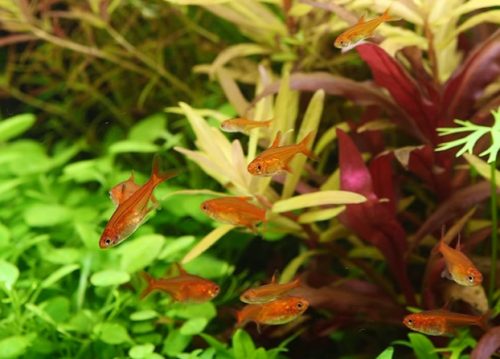
- Scientific name: hyphessobrycon amandae
- Size: 0.8″
- Tank size: 5 gallons
- Care level: easy
- Temperament: peaceful
- Water: 68-82°F, pH 5.0-7.0
- Diet: omnivore
Ember tetras are great in tiny aquariums set up as little as 5 gallons because these little guys are the smallest tetras on our list. With a maximum size of less than 1 inch, they are brightly colored specimens with prominent personalities.
Unlike some of the other tetras on this list, they will school with most other tetras. However, any fish significantly larger than them can be stressors. Low light is best for them, so give them lots of plants and other aquarium decors to provide them with some shade.
Ruby Tetra
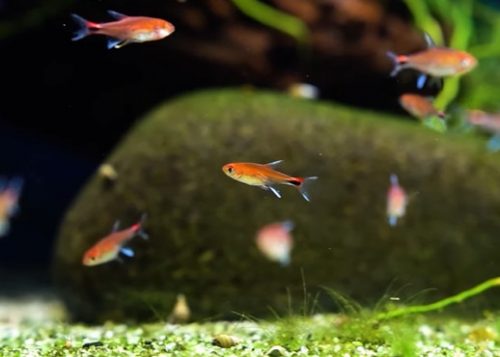
- Scientific name: axelrodia riesei
- Care level: easy
- Temperament: peaceful
- Lifespan: 5-10 years
- Size: 0.6–0.8 inches
- Tank size: 10 gallons
- Water: 68–82.4°F, pH 5–7
- Diet: omnivore
The Ruby Tetra is another tiny tetra well suited to tanks as small as 10 gallons. As its namesake implies, it is a bright red fish, almost jewel-toned, with a black spot on its rear fin. The Ruby Tetra needs at least 6 other Ruby Tetras to keep it company and lots of cover to keep it safe from bigger fish. This fish is a little rarer than other tetras. It is also not as hardy as other species on this list, so while it can handle a smaller tank setup, it’s not the perfect beginner fish.
Jelly bean tetra
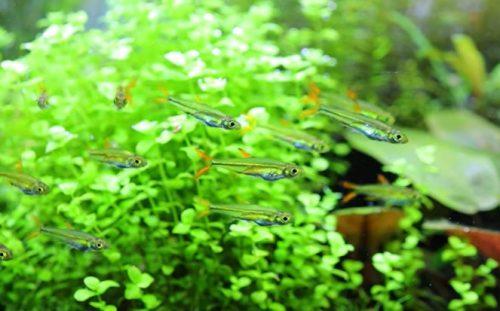
- Scientific name: Ladegasia roloffi
- Care level: easy
- Temperament: peaceful
- Size: 1.25 inches
- Tank size: 10 gallons
- Water: 76–82°F, pH 6.5–7.2
- Diet: omnivore
The tiny Jelly bean tetra is a bright neon green fish with stunning body coloring and beautiful orange highlights on its fins. Coming in at just 1 inch, the Jelly bean tetra does best if it is kept in a species-only tank with lots of other Jelly bean tetras. This is also because of the specific tank requirements jelly bean tetras have, namely a highly acidic environment with low light. Adding leaves is great for these fish as it gives them cover and can increase the acidity of the tank.
Red line tetra
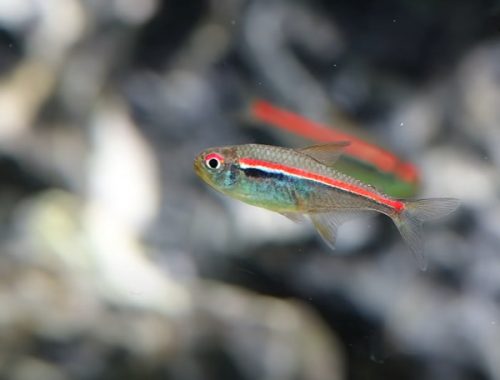
- Scientific name: Hyphessobrycon amapaensis
- Care level: very easy
- Temperament: peaceful
- Lifespan: 3-5 years
- Size: 1–1.2 inches
- Tank size: 10 gallons
- Water: 73–82°F, pH 5.8–6.3
- Diet: omnivore
The Red Line tetra is another smaller tetra, maxing out at about 1 inch long. It has a silver body with a thick red line running from front to back. The red line is underlined with a thin white and black line right beneath it. The fins can sometimes be tinged yellow.
Like most tetras, it needs to have tank mates and does well in a group of 6 or more other Red Line tetras. If it is kept with other fish, it’s important that they do not outcompete the Red Line tetra for food and that the tetra has ample cover and hiding spaces. While it can take a range of pH, it prefers more acidic tanks.
Flame Tetra
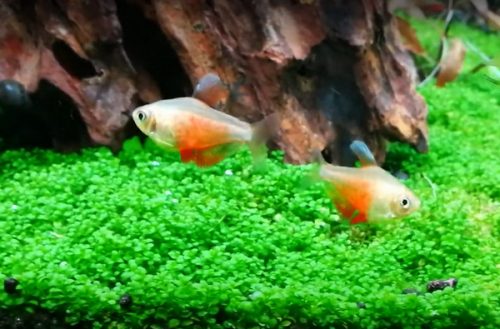
- Scientific name: Hyphessobrycon flammeus
- Care level: easy
- Temperament: peaceful
- Lifespan: 3-5 years
- Size: 0.8–1 inches
- Tank size: 15 gallons
- Water: 72–82°F, pH 5.5–7.5
- Diet: omnivore
Flame tetras, also known as Von Rio Tetras, are some of the most common tetras. They are silvery in color with a bright splash of red on their fins, which is how they earned their name.
These are an excellent choice for beginner hobbyists as they are hardy, don’t have restrictive dietary needs, and are as peaceful as they come. They handle a variety of tank temperatures well, and although they prefer acidic tanks, they do okay with some fluctuation in the acidity.
They live 3-5 years and can reach an adult size of 1 inch. Because of their tiny size, they are good in tanks as small as 10 gallons. They need to have tank mates and prefer a shoal of at least 6 other flame tetras.
Cardinal Tetra
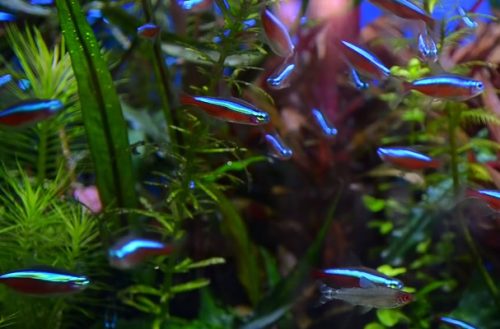
- Scientific name: paracheirodon axelrodi
- Size: 1.4″
- Lifespan: 4-5 years
- Tank size: 15 gallons
- Care level: moderate
- Temperament: peaceful
- Water: 73-81°F, pH 3.5-7.5
- Diet: omnivore
The Cardinal tetra is another popular fish among beginner aquarists. Sometimes called the Red Neon Tetra, it bears a striking resemblance to its cousin, the Neon Tetra. With an iridescent blue line across the top of its body and a deep red color extending across the bottom half, they are a vibrant and beautiful fish to look at.
They love acidic water and need lots of tank mates to feel happy. In the wild, they school in groups numbering in the thousands, but in your tank, they’ll be okay with any number more than 6. As with many tetras, they are pretty hardy, but that doesn’t code for neglect – they will still need frequent water changes to ensure the nitrate levels don’t get too high.
Neon tetra
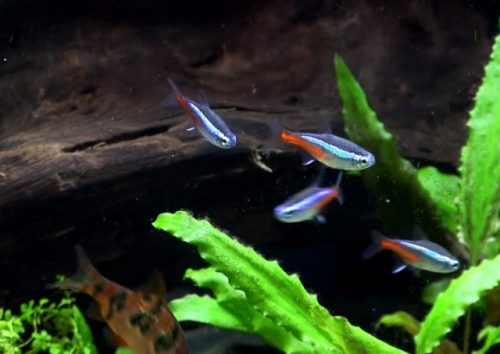
- Scientific name: paracheirodon innesi
- Size: 1.2″
- Lifespan: 2-3 years
- Tank size: 10 gallons
- Care level: easy
- Temperament: peaceful
- Water: 70-82°F, pH 4-7.5
- Diet: omnivore
Arguably the most famous tetra, if not the most famous aquarium fish, you’d be hard-pressed to find a freshwater setup without these hardy fish. Their bright blue and red iridescent coloring is distinct and attractive.
These fish should only be added to established tanks, and frequent water changes are required to keep these fish healthy. These fish are pretty robust but, like many fish, do not do well with dramatic changes to the aquarium. So again, they will tolerate a range of acidity and water temperature, but that doesn’t mean neglecting it.
Neon Tetras need a school of at least 10 or more, but their small size makes them an excellent fit for 15 gallons or more tanks. Lots of plants and hiding areas are recommended, but they also need open spaces to swim.
Green neon tetra
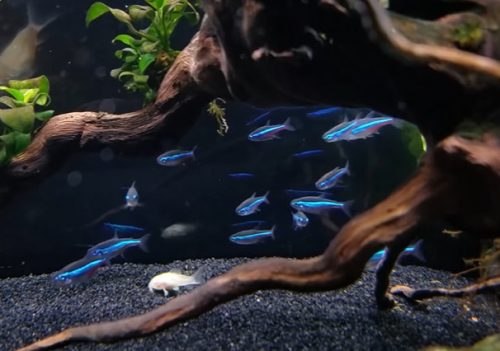
- Scientific name: Paracheirodon simulans
- Care level: easy
- Temperament: peaceful
- Lifespan: 2–3 years
- Size: 1″
- Tank size: 10 gallons
- Water: 75–85°F, pH 5–6.5
- Diet: omnivore
The Green Neon Tetra looks very similar to its more popular cousin the Neon Tetra. However, it sports a blue/green line across its body rather than a red and blue one.
It is also just a little bit smaller, at just under 1 inch. With this in mind, it has a few important requirements. The Green Neon Tetra needs to be kept in groups of 8-10 and your tank should only have peaceful, smaller fish in it. Aggressive fish will prey on these gentle green neon tetras and larger fish can stress them out. This fish is best kept with other smaller tetras and not larger, more active fish.
Black Neon Tetra
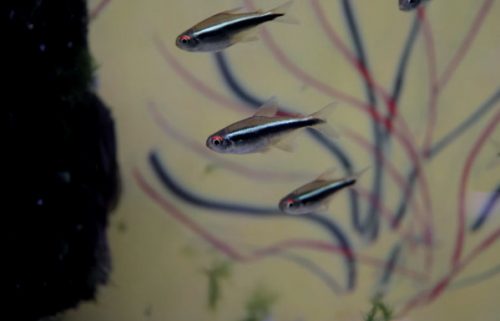
- Scientific name: hyphessobrycon herbertaxelrodi
- Size: 1.4″
- Tank size: 15 gallons
- Care level: easy
- Water: 68-82°F, pH 5-7.5
- Diet: omnivore
The Black Neon Tetra is similar to the Neon Tetra in name but is an entirely different species. The Black Neon Tetra has a bigger body than the Neon Tetra. In the center of its body, the fish is adorned with colored parallel lines with a white line above and a black line below, giving it the appearance of a braid.
The Black Neon Tetra is hardy fish but it does best in established tanks. This species will look gorgeous in a tank with a darker substrate and less bright lighting. As a schooling fish, it should have at least 5 other tank mates.
Flag Tetra
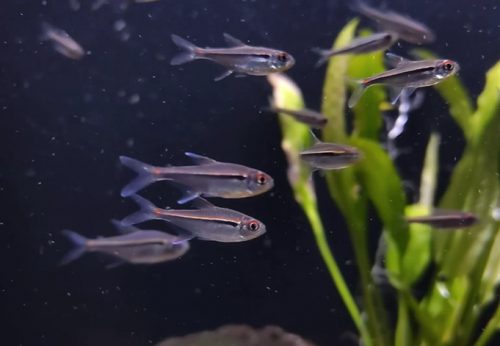
- Scientific name: hyphessobrycon heterorhabdus
- Size: 1.4″
- Tank size: 15 gallons
- Hardiness: easy
- Water: 68-79°F, pH 5.5-7.5
- Temperament: very peaceful
- Diet: omnivore
This tetra is also known as the Belgian Flag Tetra due to its red, black, and gold stripes that run along the fish’s body. They are very peaceful and get along with every fish, making them a popular choice. They do need company, so keeping them in groups of 8-10 is ideal. They can read an adult size of 1.5″ and do best in a 15-gallon or larger tank.
Black Phantom tetra
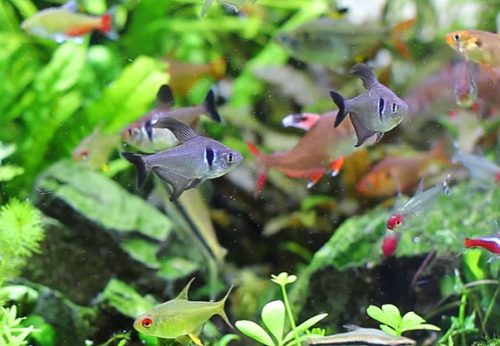
- Scientific name: hyphessobrycon megalopterus
- Size: 1.4″
- Tank size: 15 gallons
- Care level: moderate
- Temperament: peaceful
- Lifespan: 5 years
- Water: 68-82°F, pH 5.0-7.0
- Diet: omnivore
This fish is of a blocky, tetragonal shape and comes in a lighter grey color. Although it is not vibrant in color, it has long, flowy fins. In males, these fins extend during mating rituals as well as when defending their territory against other males. This may result in some damage to the fins, but they grow back.
Red Phantom Tetra
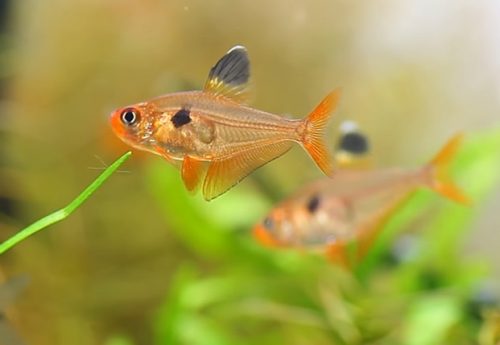
- Scientific name: hyphessobrycon sweglesi
- Size: 1.4″
- Tank size: 15 gallons
- Care level: moderate
- Temperament: peaceful
- Lifespan: 5 years
- Water: 68-82°F, pH 5.0-7.0
- Diet: omnivore
The Red Phantom Tetra is a larger tetra with a distinct red color and bears a lot of the same features as the Black Phantom Tetra. They cannot reproduce with Black Phantoms but having the two in the same setup makes for an interesting combination.
Tetras for aquariums from 20-25 gallons
Tetras for larger aquariums generally represent larger fish, have more significant schooling needs, or have quirks such as aggression or living preferences that are hard to accommodate in smaller tanks. While the tetras for smaller aquariums represent several super beginner-friendly fish, these tetras present a bit more challenge.
Rosy tetra
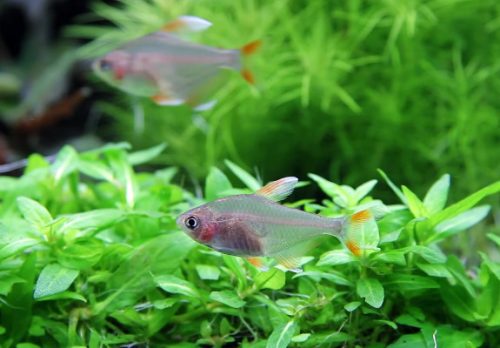
- Scientific name: Hyphessobrycon rosaceus
- Care level: easy
- Temperament: peaceful
- Size: 1.6 inches
- Tank size: 20 gallons
- Water: 75–82°F, pH 5.5–7.5
- Diet: omnivore
Their coloring as their name implies is a pale pink color with several darker red spots under the eye and along the body. Another feature of their type of tetra is the male’s large fan-like fins that come out in mating displays and interactions with other males.
Rosy Tetras are hardy tetras that can tolerate a range of pH and temperatures, although they do best in acidic water – and their coloring tends to be brighter in more acidic tanks. They get along with other peaceful fish and look great in small shoals of 6-10 other Rosy Tetras.
Rosy Tetras can be housed in community tanks. Other peaceful fish from different families of fish do well with the Rosy Tetra because of its easy-going nature but also because of its overall rounder shape that is not as intimidating to other fish.
Blue Tetra
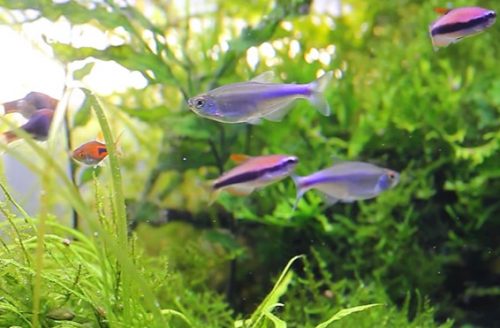
- Scientific name: Knodus borki
- Size: 2″
- Temperament: slightly aggressive
- Tank size: 20 gallons
- Care level: easy
- Water: 72-78°F, pH 5.5-7.0
- Diet: omnivore
- Lifespan: 2–4 years
The Blue Tetra is more immense, coming in at 2″ adult size. With that in mind, it does need a larger tank set up of a minimum of 20 gallons. It is very lively and can be borderline aggressive, so keep this in mind when adding to a tank. Blue Tetras do well with other tetras, just make sure that everyone has enough space and cover to hide if things get tense.
Rainbow Tetra
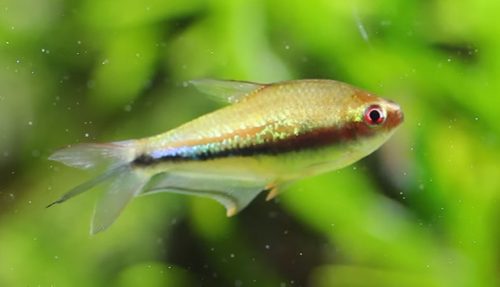
- Scientific name: Nematobrycon lacortei
- Care level: easy
- Temperament: semi-aggressive
- Lifespan: 3–5 years
- Size: 1.2–1.5 inches
- Tank size: 25 gallons
- Water: 72–80°F, pH 5–8
- Diet: omnivore
The Rainbow Tetra is another larger, more aggressive tetra. It thrives in 25-gallon or larger tanks and prefers to be part of a school of between 6-10 fish. The Rainbow tetra has a beautiful iridescent display in the male fish, with the females a little more muted but equally as lovely to behold.
Rainbow Tetra can become aggressive between males of the same species but also to other tetras and fish that look similar. This is why a larger tank and lots of decors are highly recommended. This is not a beginner-friendly tetra, but given the proper set up can be a rewarding fish to observe and even breed.
Pristella Tetra
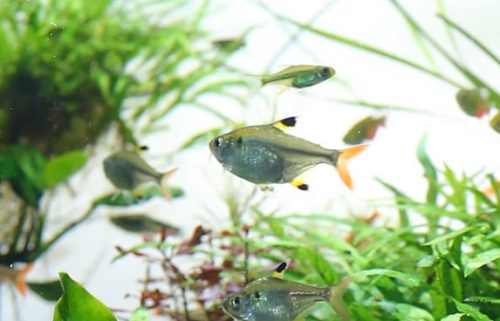
- Scientific name: pristella maxillaris
- Size: 1.8″
- Tank size: 20 gallons
- Hardiness: easy
- Water: 72-82°F, pH 6.0-7.5
- Diet: omnivore
The Pristella Tetra is another larger tetra, growing to about 1.8″ when fully grown. With this in mind, 20 gallons or more is best for this fish. They are pretty tolerant of temperature change and prefer a slightly acidic tank. Keep them in shoals of at least 6 specimens. They are an excellent choice for community tanks as they are incredibly peaceful and frequently found in tanks that have other tetras and dwarf cichlids.
Candy Cane Tetra
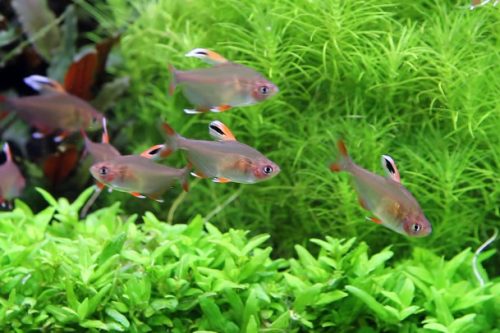
- Scientific name: Hyphessobrycon bentosi
- Care level: easy
- Temperament: peaceful
- Lifespan: 3–5 years
- Size: 1.6–1.8 inches
- Tank size: 20 gallons
- Water: 73–82°F, pH 6.0–7.2
- Diet: omnivore
Candy Cane Tetras are a shoaling species that need to be kept in groups of at least 6 or more specimens. As a peaceful species, they can be kept with many other similar-sized and temperamented fish. They do best in a darker, 20-gallon or larger aquarium that is densely planted and aquascaped with a few pieces of driftwood and river rock. They are a bit larger in size and their pink color often gets them confused with the Rosy tetra.
Bloodfin Tetra
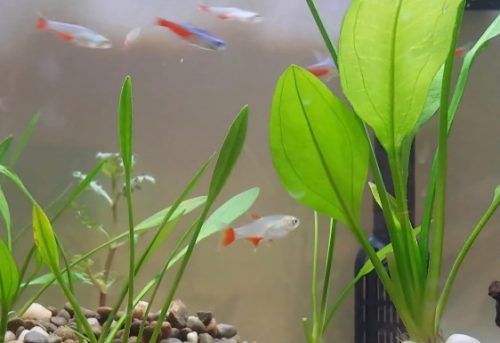
- Scientific name: aphyocharax anisitsi
- Size: 2.2″
- Tank size: 20 gallons
- Care level: easy
- Water: 64-82°F, pH 6.0-8.0
- Temperament: peaceful, but nip fins of angelfish and guppies
- Diet: omnivore
The Bloodfin Tetra has a distinct appearance, with bright-colored bodies accompanying blood redfin tips. They are significant for tetras coming in at 2.2″. While they tend to be peaceful overall, they can sometimes nip the fins of other fish with fancy fins like guppies or angelfish. Although they do well with most other fish. They are hardy and deal with tank changes well. Keeping them in schools of 6-10 is a good idea as this fish loves company.
Emperor tetra
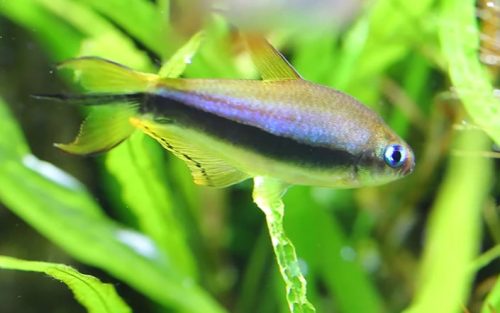
- Scientific name: nematobrycon palmeri
- Size: 1.6″
- Tank size: 20 gallons
- Care level: easy
- Water: 73-81°F, pH 5.0-7.5
- Diet: omnivore
Coming in at 1.6″, the Emperor Tetra needs a 20-gallon tank. Even though these fish are only found in Columbian rivers, they can be kept in a community aquarium or river setup. The Emperor Tetra is a particularly striking fish with a bold color scheme. This allows it to blend in with any South American style tank, including those with corydoras, discus, and other tetra species.
This fish is recognized by its bold black stripe on each side of its body. As they mature, a yellow tint can appear mainly on the top of their bodies, with a purple hue. This coloration is particularly prominent in males who develop longer fins and a long ray in the center of their caudal fin.
Rummy nose Tetra
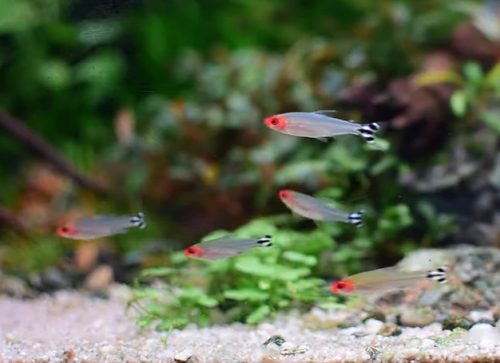
- Scientific name: hemigrammus rhodostomus
- Size: 2″
- Tank size: 20 gallons
- Hardiness: easy
- Water: 76-80°F, pH 5.5-7.0
- Temperament: peaceful
- Diet: omnivore
The Rummy Nose Tetra grows to 2″ and as a result, requires 20 gallons or more. It is a stunning fish with exciting coloration. Because it comes from blackwater rivers and tributaries in the Amazon, it does better in a natural blackwater setup. You can replicate this setup by adding decaying organic materials high in tannins. However, the Rummy Nose can tolerate a tank that’s a little less acidic as well, so it is not off the table if you are not willing to make the effort to create a black water tank.
Diamond Tetra
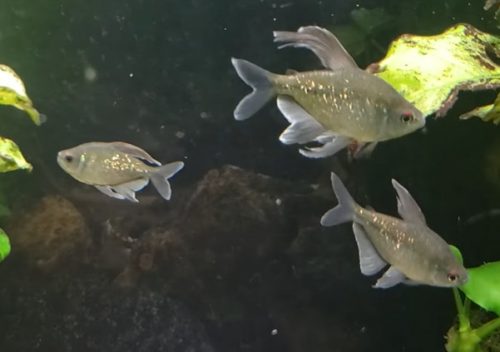
- Scientific name: moenkhausia pittieri
- Size: males to 2.4″, females smaller
- Tank size: 20 gallons
- Water: 72-82°F, pH 5.5-7.0
- Hardiness: easy
- Temperament: peaceful
- Diet: omnivore
The Diamond Tetra is one of the bigger tetras on this list, with males coming up to 2.4 inches and females slightly smaller. A 20-gallon tank perfectly suits their needs, but if you plan on breeding them, you should opt for a bigger tank where you can separate their young. Diamond Tetra are very easy to breed, so it is not uncommon for aquarists to find fry swimming around in the tank. These fish do best in a community tank with lots of plants to hide in.
Black Skirt tetra
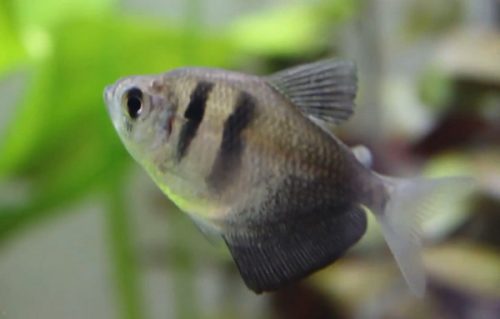
- Scientific name: gymnocorymbus ternetzi
- Size: 2.4″
- Tank size: 20 gallons
- Hardiness: easy
- Water: 68 – 78°F, pH 6.0 – 7.0
- Temperament: peaceful
- Diet: omnivore
Another large tetra, at 2.4″ this guy needs a 20-gallon tank as well. They are a stunning black patterned fish that’s a perfect addition to beginner setups. They come in lots of different styles, with some specializations in fin lengths. Even different mutations result in different colors available on the market. Besides being hardy, these fish are pretty easy to breed as well, so lots of hiding spots should be included in the tank.
Head and tail light Tetra

- Scientific name: hemigrammus ocellifer
- Size: 1.8″
- Tank size: 20 gallons
- Hardiness: easy
- Water: 75-82°F, pH 5.5-7.5
- Temperament: very peaceful
- Diet: omnivore
These aptly named tetra are some of the most common tetras around. They spawn easily and so have been part of the aquarium beginner staples for an extended period of time. With this in mind, a larger tank of 20 gallons is great if you plan on having some room for youngs. Maxing out at just under 2″, these fish love to be around other fish and are also really hardy. Acidic water is best for most tetra species, but these fish can tolerate water all the way up to a 7.0 pH.
Sarpae Tetra
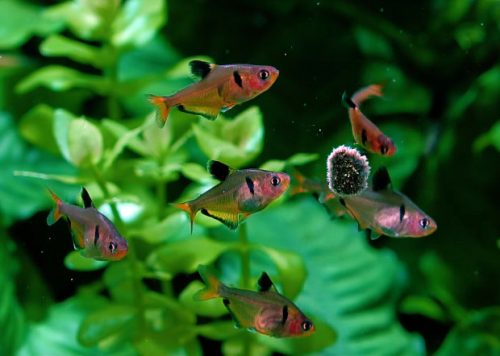
- Scientific name: hyphessobrycon eques
- Size: 1.6″
- Tank size: 20 gallons
- Hardiness: easy
- Water: 68-82°F, pH 5.5-7.0
- Temperament: fin nipping
- Diet: omnivore
Serpae tetras have a bright red body with a black diamond behind their gills and black stripes along with their relatively long fins. In contrast to many other species of tetra, these fish are bright, colorful, and active.
Plant tanks with bogwood and roots provide an excellent contrast to these fish. Maintain a slightly lit tank with lots of plants if you want your fish to develop the most vibrant coloration. As long as you give them soft, acidic water to live in, there isn’t much of a challenge to keep serpae tetras.
I recommend at least a 20-gallon tank for a group of 8 specimens. It is wise to house them in a large aquarium with no long-finned fish or slow-moving fish (such as angelfish and guppies) because of their tendency to nip at other fish’s fins.
Glowlight Tetra
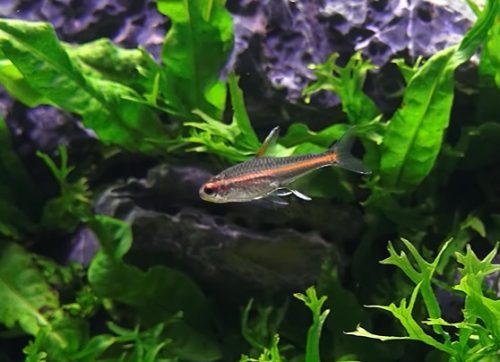
- Scientific name: hemigrammus erythrozonus
- Size: 1.6″
- Tank size: 20 gallons
- Care level: easy
- Water: 75-82°F, pH 5.5-7.5
- Diet: omnivore
The species has a silvery color with a bright red/orange stripe from the tail to the nose, which is where it gets its name. As many tetras are, it is calm and gets along with most other fish of the same type. It is hardy but does better with more hiding places and acidic water.
Penguin Tetra
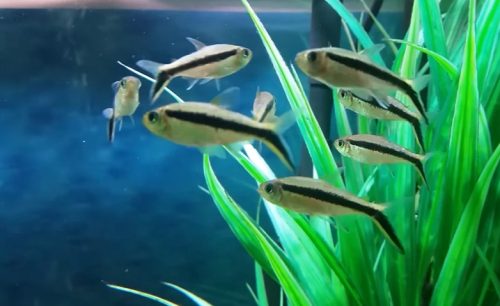
- Scientific name: thayeria boehikei
- Size: 1.4″
- Tank size: 20 gallons
- Care level: easy
- Water: 73-82°F, pH 5.5-8.0
- Diet: omnivore
It is quite easy to distinguish between the penguin tetra and other tetras because it has a shiny silver belly accompanied with a black stripe that goes across its body. These are another fish that do well in a beginner community setup. Keeping at least a few Penguin Tetra together is the best option, however, you can also add other similarly sized tetras.
Lemon tetra
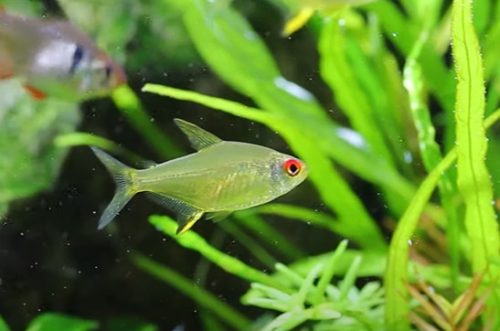
- Scientific name: hyphessobrycon pulchripinnis
- Size: 1.6″
- Tank size: 20 gallons
- Hardiness: easy
- Water: 68-82°F, pH 5.0-7.5
- Temperament: peaceful
- Diet: omnivore
Lemon tetras are beautiful fish, with light yellow coloring. Their bodies are almost transparent with fins marked with black and yellow. Their bright red eye can be an indicator of health – being more vibrant usually means more healthy. Lemon Tetras do better in densely planted tanks. They need a group of at least 8 other lemon tetras.
Tetras for large aquariums above 29 gallons
Blind cave Tetra
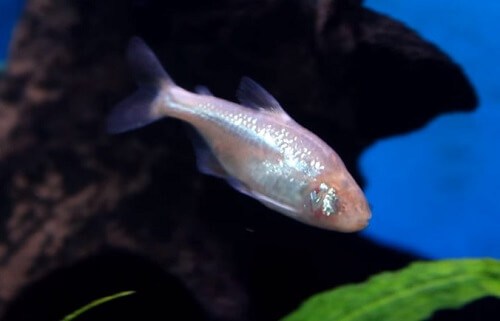
- Scientific name: astyanax mexicanus
- Size: 3.5 inches
- Tank size: 29 gallons
- Water: 68-77°F, pH 6.5-8.0
- Temperament: peaceful
- Diet: omnivore
These are some of the more unique fish on this list. As the name implies, they are totally blind. Since they don’t go by their vision, they don’t need an elaborate setup – but having some nooks and crannies for them to hide in is good. To keep these guys safe, it is best to only put them with other non-aggressive fish.
Bleeding Heart Tetra
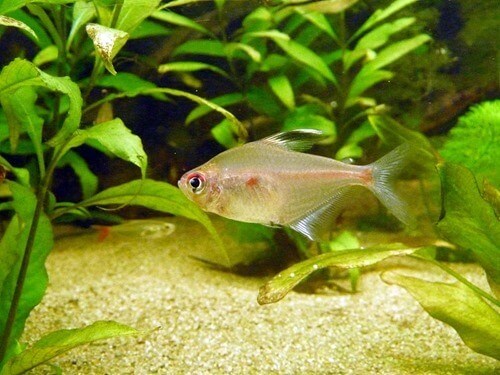
- Scientific name: hyphessobrycon erythrostigma
- Size: 2.4″
- Tank size: 30 gallons
- Hardiness: Easy
- Water: 70-82°F, pH 4.0-7.5
- Temperament: peaceful
- Diet: omnivore
The bleeding heart tetra has a silver and white body with pink patterns. It also has a small red dot on both parts of the body, looking vaguely like a heart. It is best to keep a small group of approximately six or eight specimens in a tank size of approximately 25 gallons. Aquatic plants are not necessary for this species as they do not feature in their natural habitat.
Buenos Aires tetra
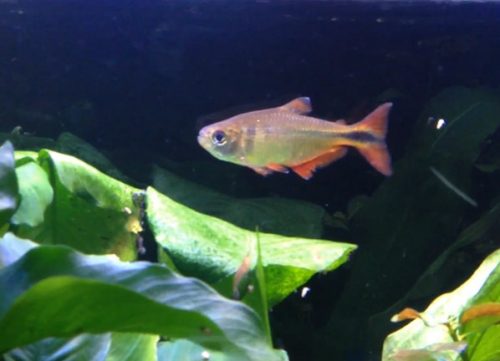
- Scientific name: hyphessobrycon anisitsi
- Size: 2.4″
- Tank size: 30 gallons
- Hardiness: easy
- Water: 64-82°F, pH 5.5-8.5
- Temperament: may nip fins of tankmates
- Diet: omnivore
The Buenos Aires Tetra is an incredibly adaptable fish. They can thrive in nearly every water condition. The only thing to note is that as Buenos Aires Tetras get bigger, they can begin to nip fins. Keeping longer finned fish out of the tank, or keeping these fish in a larger setup alleviates most of these problems.
Red-eye Tetra
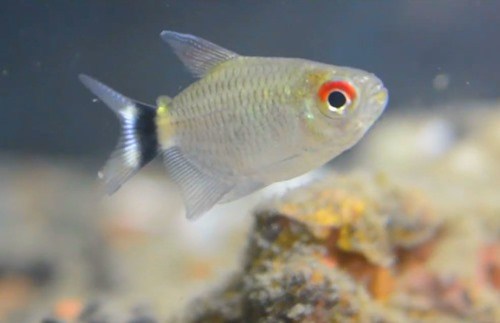
- Scientific name: moenkhausia sanctaefilomenae
- Size: 2.8″
- Tank size: 30 gallons
- Care level: Easy
- Water: 72-79°F, pH 6.0-8.0
- Temperament: nib fins of long fin fish
- Diet: omnivore
The red-eye tetra features a silvery body with a broad black colored bar on its tail. As the name implies, it has red eyes. They prefer smaller shoals than the other fish on this list. While planted tanks suit most tetras, the red eye tetra will chew on plants, so be aware. They will also nip at long-finned fish.
Congo Tetra
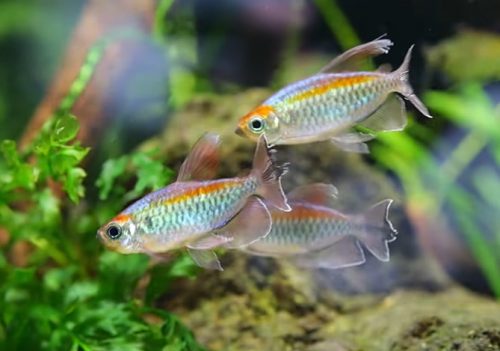
- Scientific name: phenacogrammus interruptus
- Size: 3.2″ (male), 2.4″ (female)
- Tank size: 55 gallons
- Hardiness: easy
- Water: 73-82°F, pH 6.0-7.5
- Temperament: peaceful
- Diet: omnivore
Although larger in size, Congo tetras are peaceful and do well with other fish in a densely planted aquarium. The Congo Tetra can be harmed by other more aggressive fish, so make sure to only house it with other peaceful fish. While it is larger, it does fine with other smaller tetras and has even been seen schooling with them.
Size aside, the colors of this fish are a remarkable sight. With a bright iridescent body and a red head with a stripe extending the length of its body, it is a swimming rainbow. Making sure the water is suitably acidic and the tank is well planted are keys to keeping this fish happy and healthy.
Bucktooth Tetra
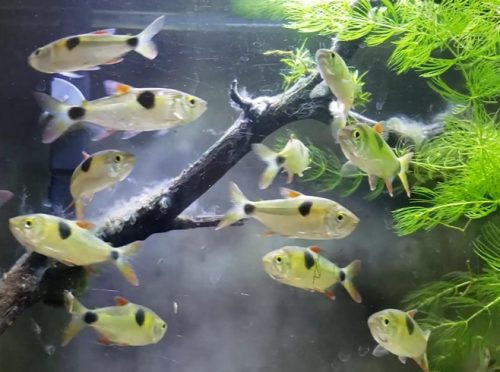
- Scientific name: exodon paradoxus
- Size: 4 inches
- Tank size: 40 gallons
- Water: 73-82°F, pH 5.5-7.5
- Temperament: very aggressive, only for a species setup
- Diet: omnivore
The Bucktooth Tetra is a rare find that is only recommended for advanced aquarists. It is aggressive and rather large for a tetra, coming in at 4-6″. I don’t often describe fish this way, but the Bucktooth Tetra is pretty disturbing. It will literally eat the scales off of other fish and at the fish’s risk to health, cannot be put in the same tank as a Bucktooth or it will slowly get eaten alive.
The Bucktooth Tetra needs to be kept well fed or it will turn on its tankmates, even the same species. It needs at least 40 gallons. Only other Bucktooth Tetras can be kept in the same tank, and it’s recommended that even with a species set up, fish behavior is closely monitored.
Final thoughts
As you can tell from this list of tetras perfect for any size setup, tetras represent a variety of peaceful, beautiful species of fish. While most of these fish are great beginner fish, know that there are tetras for aquarists of any knowledge and skill level, as evidenced by some of the tetras for larger tank setups. As you move to add a few of these fascinating fish to your tank, keep in mind the helpful tips presented in this article, and be sure to do your own research to ensure your setup is healthy and successful.

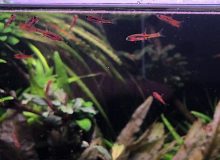
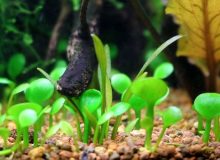
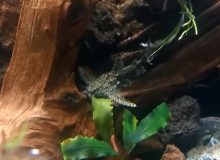
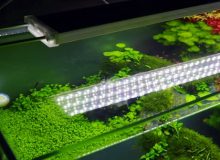
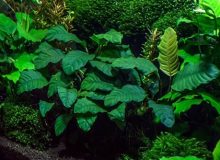
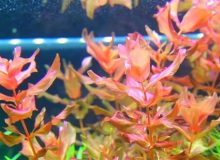
Leave a Reply